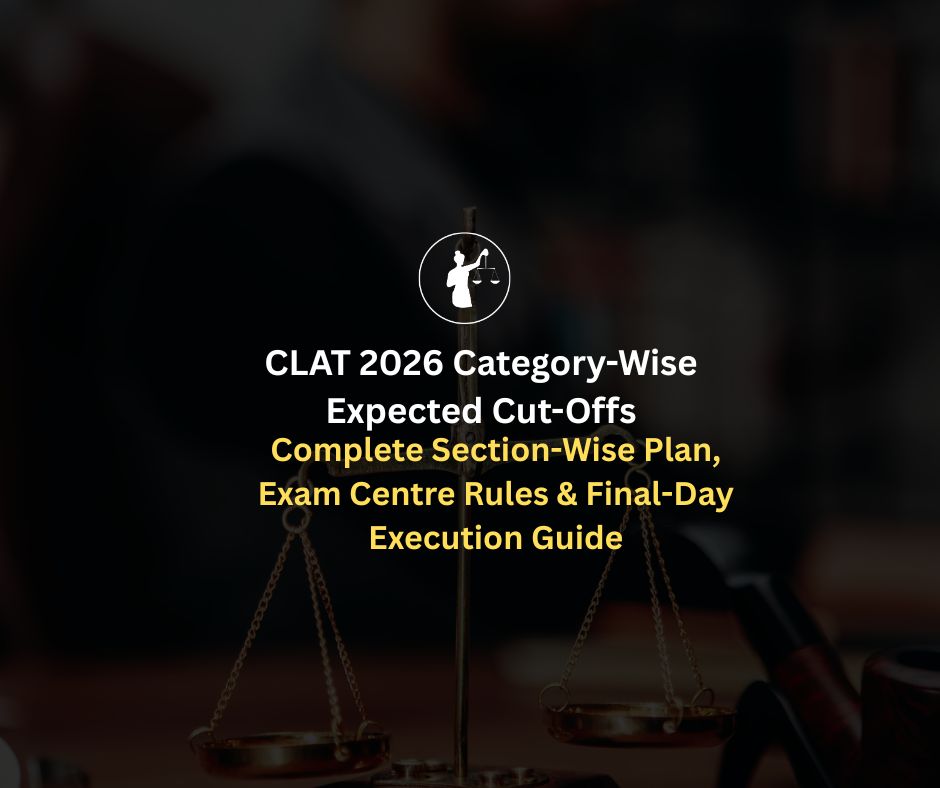
Why Mock Tests Matter More Than You Think in CLAT 2026
You’ve probably heard this a thousand times already “Give more mocks.”
But if it were that simple, everyone giving 40–50 mocks would automatically end up in a top NLU. They don’t. Because it’s not just about how many you give it’s about how you give, how you analyse, and what you change after.
Everyone says mocks are important — and they are. But few talk about how they shape your prep: not just as practice, but as a mirror for everything you’re doing wrong… or right.
Join Our Telegram for Latest Updates
CLAT isn’t a memory test. It’s a performance test under pressure.
And in 2026, with 120 questions in 120 minutes, every question counts more than before.
Also Read: How to Manage Time During CLAT Preparation
Mocks are the only place you practice the actual pressure of:
Managing time per section when you feel stuck
Staying calm when a full RC passage feels unreadable
Skipping questions smartly without panic
Recovering focus when one section goes badly
Your books, coaching, or YouTube videos can teach you concepts —But only mocks can teach you delivery.
Here’s where most aspirants go wrong:
They give mocks → check their score → feel good/bad → move on.
No pause. No post-mortem. No system.
But toppers? They treat every mock like a performance lab.
After each mock, they ask:
Where did I lose most time?
Was my first section my strongest?
Which questions broke my flow?
Did I blank out or overthink?
They don’t just track “mistakes.” They track patterns. Because a mock isn’t a prediction. It’s a diagnostic.
Also Read: CLAT Prep Guide: Build the Right Strategy from Day One
Let’s say you’ve given 20 mocks. Scores start dropping. You feel stuck.
You either:
a) Take a break and wait for “motivation,” or
b) Keep pushing without changing anything
Neither works. Because this isn’t a motivation issue it’s an analysis issue.
Toppers go deeper. They break mocks into layers:
Layer 1: Accuracy per section
Layer 2: Time spent vs time planned
Layer 3: Type of errors, panic? misread? over-attempting? Skipping too fast?
Layer 4: Mental state, anxious? rushed? sleepy?
When you analyse like this, every mock becomes a mirror. And if you keep fixing what it shows, improvement is guaranteed.
Also Read: CLAT 2026 Competition: How Tough Will It Be
Here are a few non-obvious things toppers do after mocks that make all the difference:
Instead of writing “Q5 wrong - GK,” they note:
Why was I unsure? Lack of context? Confused two options?
Can I recall the source of this? If not, my GK source is failing.
Legal wrong?
Misread fact or principle?
Did I panic because the options were close?
Did I spend more than 3 mins on it?
This kind of log helps you fix your process, not just your memory.
They mark the start and end time of each section.
So when they say, “I took 30 minutes in Legal,” they also check:
Was that extra 5 mins worth it?
Did it boost my accuracy or just drain my energy for QT?
They make time decisions based on data — not guesswork.
It sounds odd, but toppers rate their mindset in each mock:
Calm?
Anxious?
Distracted?
Low energy?
Because sometimes your mock score isn’t a skill issue — it’s a mental rhythm issue. Once you spot it, you can fix it.
There’s no fixed number.
Some crack it in 30. Some need 60+. The key is:
How early did you start?
Are you changing things based on each one?
Are you mixing full mocks with sectionals and speed drills?
But here’s a rough structure toppers follow:
April–June: 1 mock/week, full analysis, build stamina
July–August: 2/week, start tracking time more strictly
Sept–Nov: 3/week, intense analysis, pressure training
Dec: Alternate days, keep rhythm, light analysis
They don’t just count mocks. They count lessons per mock.
Also Read: CLAT Exam Attempts: How Many Times Can You Appear
Your prep books won’t tell you:
That you blank out after 60 minutes
That you misread long RCs when panicked
That you lose steam if you start with QT
That you over-attempt in Logical every time
Only mocks will. If you listen. That’s why mock-taking is a skill. And like any skill, it needs feedback, correction, and repetition.
Let’s get into mock-specific strategies for each section.
English + RC
Always check your accuracy after each mock — RC can feel “easy” and still hurt you
Skim the passage once, then read the question. Don’t re-read unless necessary
Time: 22–24 mins max
GK
Don’t overthink. First instinct usually wins
If unsure between two, flag and return later. But don’t waste more than 10 secs per Q
Time: 8–10 mins only
Legal
Don’t “fall in love” with the passage. Read facts once, move to options
Keep your Legal notes handy for reviewing mistakes — pattern spotting is key
Time: 28–30 mins
Logical Reasoning
Use POE (process of elimination) aggressively
Identify why an option is wrong — not just why one is right
Time: 25–27 mins
Quantitative Techniques
If the first QT looks tough, move on. Don’t let it block your flow
Practice calculation drills under pressure
Time: 10–12 mins
Every error is recycled into a learning.
Every analysis fixes a timing flaw.
Every pressure point becomes familiar.
By December, they’re not scared of the clock. They’ve trained under it so often that the real exam feels like just another mock.
That’s what separates them.
We design a system:
Timed mocks that simulate real CLAT pressure
Post-mock feedback not just about scores, but about time splits, accuracy shifts, and mental performance
Mentor-led analysis where you learn how toppers decode every mock
Mock strategy plans tailored to your weak zones — not some generic advice
Check Out the CLAT Course Here: CLAT Online Coaching: Best Mentorship for CLAT 2026
We know you don’t need another PDF dump. You need structure. Pressure training. And someone to track your blind spots before they cost you your dream college.
Because in the end, CLAT isn’t won by the one who knows the most. It’s won by the one who can stay calm, adapt fast, and deliver when it matters most.
And mock tests, if done right, are the fastest way to build that version of you.
Frequently Asked Questions on CLAT 2026?
You should ideally attempt around 30 to 40 full-length mock tests before the final exam. This gives you enough practice to build consistency without exhausting your mental energy.
Start at least six to seven months before the exam. Don’t wait for syllabus completion. Early mocks build foundational exam temperament and expose early mistakes.
Yes, you should. Mocks are not just meant to test what you’ve already learned—they train your focus, decision-making, and time management. Attempt what you can and use the rest for diagnostic learning.
Once a week is ideal in the beginning. As you approach the final three months, increase it to two or even three per week, but only if you’re analyzing them thoroughly. Frequency means little without reflection.
After every mock, check your time spent per section, number of attempts vs accuracy, and the kind of errors made. Focus on identifying patterns in your mistakes so that you don’t repeat them. Analysis matters more than the score.
Yes, after a gap of three to four weeks. Retaking mocks helps track improvement in reading speed, accuracy, and confidence under similar conditions. It’s not about remembering answers but about measuring actual progress.
Absolutely. Early mock scores are not an indicator of your final performance. They help you understand what’s lacking and where to shift focus. It’s your growth curve that matters, not a single number.
Shift focus from the score to patterns. Ask yourself whether your time splits are improving or your conceptual clarity is getting better. Momentum builds from consistent effort, not one perfect mock.
If CLAT is offline, make sure most of your mocks are taken in pen-paper format. However, online mocks are helpful for sectional timing, quick review, and flexibility. Use both formats strategically.
No mock can replicate CLAT exactly, but well-designed mocks help you prepare for the unpredictability of the real paper. Their value lies in building your ability to adapt, not in predicting exact questions.





